Which products do I need for our overseeding and aeration needs?
Related Articles
Overseeding and aeration are vital operations greenkeepers must carry out to maintain turf health. Here’s a guide to the products and companies that offer help.
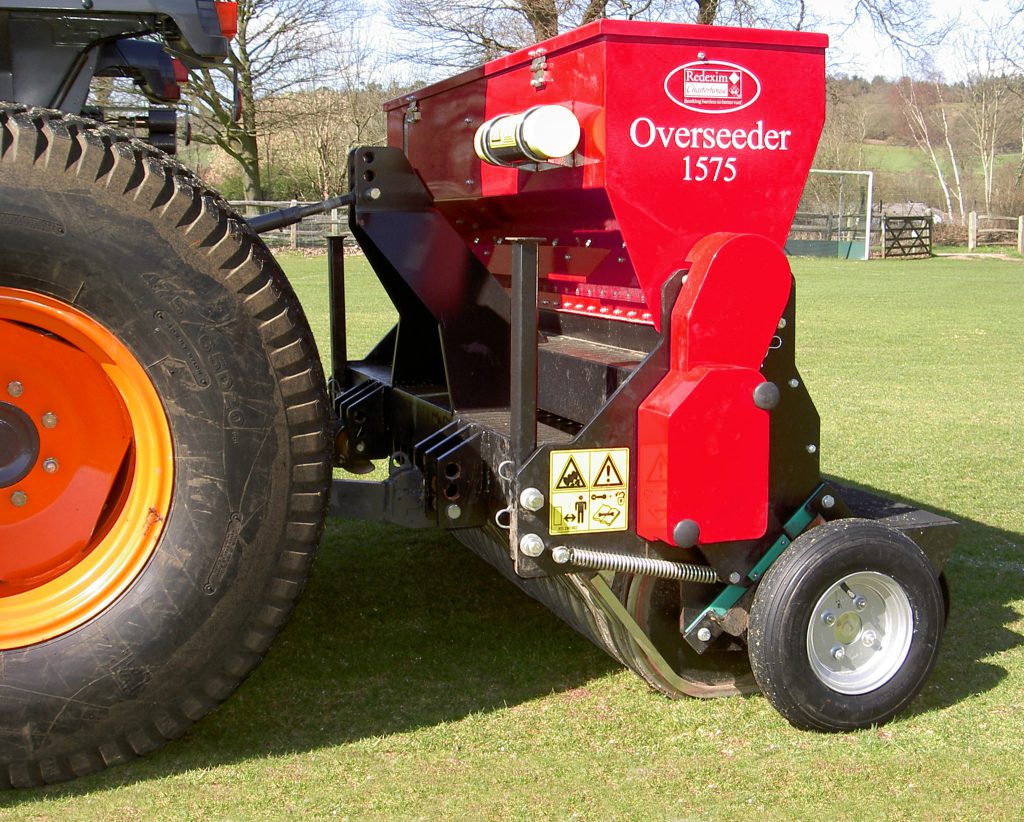
Aeration remains one of the most fundamental activities for any turf manager. Getting out with a Verti-Drain® during the winter months, to a depth of 12 or 14” during any relatively dry periods, will help to keep surfaces playable; draining and free from puddling. Followed up with further verti-draining through the spring, it will encourage a deeper-rooting, stronger plant that is better able to withstand more challenging conditions. Linear aeration provided by the Redexim Verti-Quake® is another option. The rotary motion, combined with the forward speed, sets up a wave action which helps to decompact a surface and encourage deep rooting.
Through periods of drier weather, micro-tining can be employed on greens to help keep the surface from capping over and create a path down through the profile, helping to maximise the effects of any irrigation and nutritional programmes.
If grass coverage has already been comprised, then a recovery programme should be careful and considered to prevent the risk of causing any further damage. Here, turf managers should be looking at a scarification programme to remove dead organic material, followed up with effective recovery overseeding.
The key for successful overseeding is to deliver the new seeds into an aerated rootzone and not into thatch. This is where you could consider getting out once again with your Verti-Drain®, in conjunction with a scarifier/verti-cut unit such as the Redexim Verti-Cut 1300.
Charterhouse Turf Machinery observed a surge in the demand for overseeders, following the dry weather last summer as groundsmen attempted to regain turf cover ahead of the winter season. In these situations, where high germination is the priority, disc seeders should be the tool of choice.
The Redexim Overseeder, is available in three working widths up to 2.08m and features discs spaced at 75mm. Also available are the Double Disc Overseeders. The Double Disc range contains three machines, the 1430, 1830 and 2230, offering working widths of 1.4m, 1.83m and 2.2m respectively.
Overseeding
Germinal
As tightening input budgets and the trend towards earlier cutting at low heights puts increasing pressure on browntop bents and fescue swards, greenkeepers should consider how the latest generation of ‘super bents’ can improve their putting greens says Paul Moreton, technical sales representative for Germinal, who believes that 007 DSB Creeping Bent could be the cultivar of the future.

“The species’ inherent traits of traditional browntop bents and fescues can only be improved to a certain extent,” Paul explained. “Therefore, where clubs are increasing their wear, play and traffic – whilst at the same time reducing inputs and mowing at lower cutting heights for longer – there is a need for newer, better performing cultivars to be introduced.”
Despite having input requirements on a par with existing browntop bents, the latest high-performance ‘super bent’ varieties exhibit exceptional resistance to disease and are able to vigorously outcompete undesirable species. They also offer improved levels of heat and cold tolerance as well as good fineness of leaf and a dense growth habit.
Of the new generation of ‘super bent’ cultivars, 007 DSB Creeping Bent is arguably the best of the best. It delivers all the qualities of a top-rated creeping bentgrass (prostrate growth habit, high shoot density and good wear tolerance) in a range of climatic conditions. It also offers good resistance to anthracnose, fusarium and snow mould, and is exceptionally resistant to dollar spot.
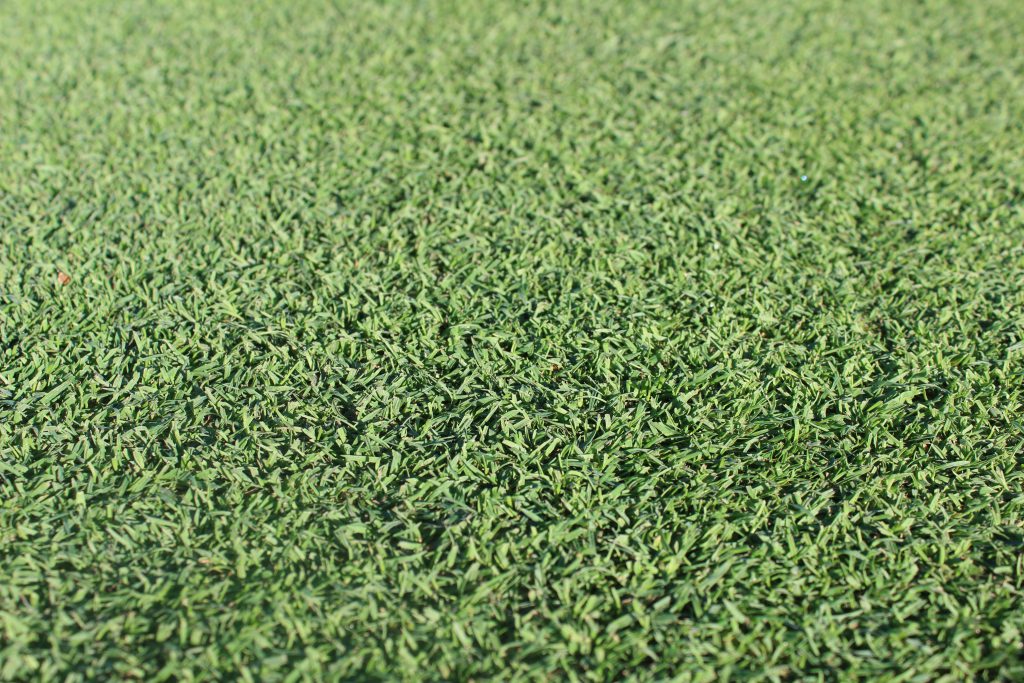
007 DSB is able to deliver these benefits with a reduced requirement for water and nutrients thereby enabling it to be easily maintained alongside existing browntop cultivars, he added.
Modern creeping varieties can also help greenkeepers achieve the fast green speeds. They have a much more prostrate growth habit which enables them to easily persist at a cut height of 3mm or slightly lower, while still maintaining turf density, giving them the advantage in this modern age of fast green speeds.
SISIS
Derek McJannet, head greenkeeper at Matlock Golf Club, says his SISIS Variseeder 1300 has proved to be a fantastic asset.
With course maintenance proving challenging with a small team, Derek started to research machinery to improve quality while saving time and selected the SISIS Variseeder after a trial loan following an incident last year.
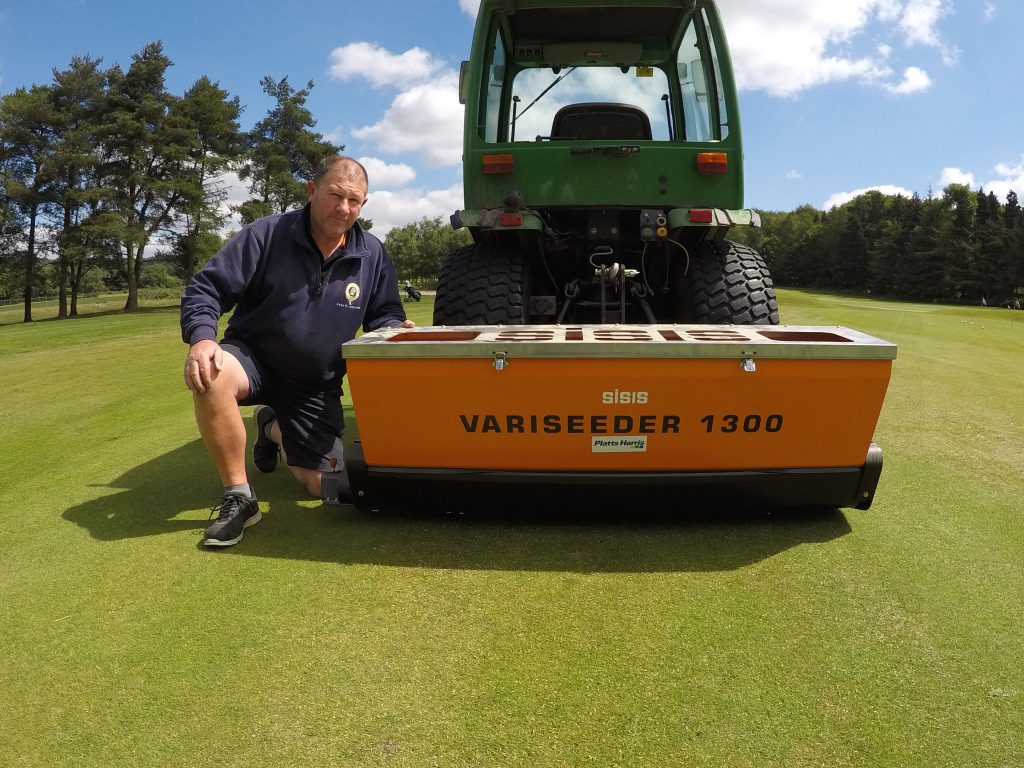
Derek said: “We experienced some damage on some areas of the course. We needed to find a quick solution and ended up borrowing a SISIS Variseeder from a neighbouring golf club. With the machine we were able to double pass all of the tees with seed, feed them and they came back to a better standard than what they were before. This was when we knew that we needed to get one of our own. I think the results from the Variseeder we borrowed convinced the committee as well.”
The SISIS Variseeder is a versatile easy-to-use tractor-mounted seeder with a variable seeding rate ideal for golf course maintenance. It has a fast work rate, is low maintenance with few wearing parts and enables overseeding to be undertaken without taking ground out of play. Complete with a studded roller, the Variseeder prepares the seedbed by creating thousands of little ‘plant pots’ to receive the seed without linear grooves that can disturb play.
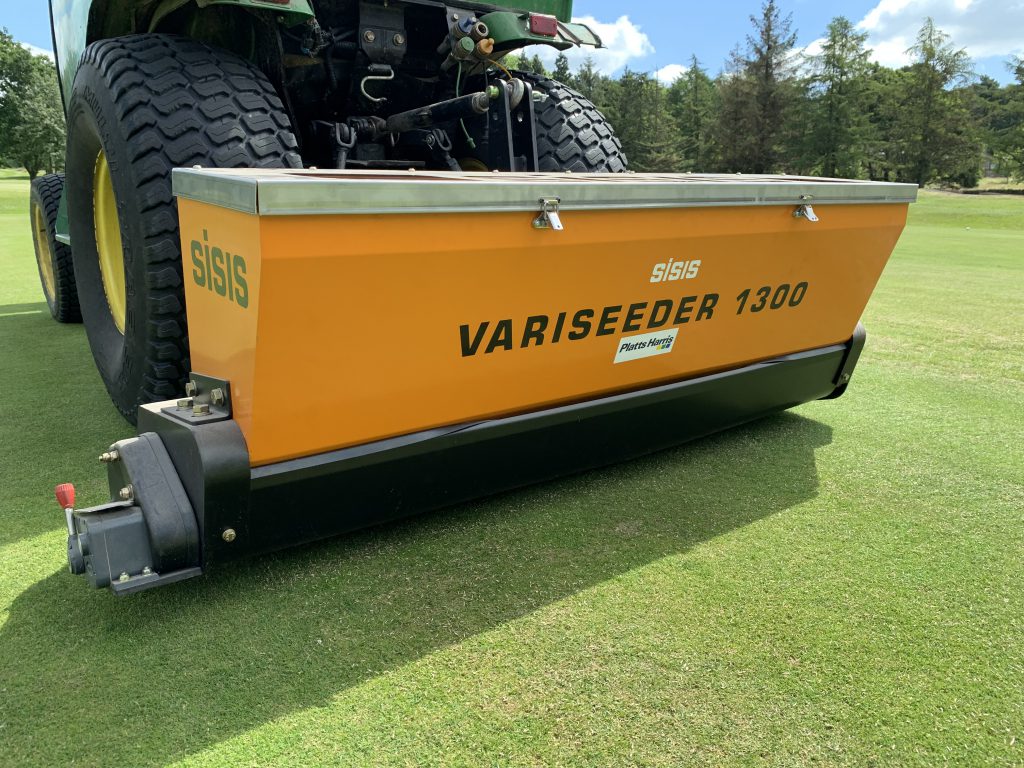
“For us the biggest benefit is that it just saves us so much time,” said Derek. “It is now just a one-man operation, whereas before there were two or three of us doing it all by hand. From start to finish, we can get all of the areas completed in just a couple of days. The Variseeder is also incredibly easy to use, is fast and effective and we are seeing much better coverage and a more uniformed establishment compared to when we were doing it by hand. Maintenance-wise it is a dream and we hardly have to worry about it.”
DLF
New for DLF in 2019 is the ‘DLF Select’ quality programme and seed range which safeguards quality and high purity standards.
DLF Select ‘00’ quality guarantees the highest purity based on a standard ISTA analysis. In a standard sample of the ‘00’ quality grass seed, 0.0 per cent of other seeds are found. For even further reassurance, a 10x sample search is performed for the ‘S’ grade. The superior ‘S1’ standard guarantees the result of 0.0 per cent, while ‘S2’ indicates no coarse grasses, with only traces of non-harmful dicot species. Besides the Select purity grades, DLF also offer professional ‘A1’ and ‘A2’ grades for the amenity market, that offer a vast improvement on the baseline EU purity rules and standards.

Meanwhile DLF seed mixes are helping Cheshire’s Adlington Golf Centre create a brand new nine-hole par three course of high quality.
Owner and managing director David Moss has turned once more to Johnsons Sports Seed mixtures, from DLF, after being previously impressed with results.
He said: “When we built the previous par three course in 2003, we used seed from DLF.
“With the new course constructed as a like-for-like replacement, we decided to stick with the same mixtures in order to minimise the changes in both playability and appearance.”
Johnsons Sports Seed, J Rye Fairway and J Green mixtures were selected. “While these are the same mixtures as we’ve used before, we now benefit from the improved cultivars thanks to the DLF breeding programme. J Green has always given us fast, true greens while the Rye Fairway mixture has proven to be very hard-wearing on the high-traffic areas. Both have continuously delivered strong colour for fantastic presentation. We are delighted with how the ‘grow-in’ phase has progressed, with reps, suppliers and the course architect alike, all commenting on the impressive coverage and appearance,” he said.
Aeration
Ecosol
There are few single procedures than can produce as many benefits for the grass as aeration. Creating air space in the soil produces a healthier plant. It improves the rate with which water moves into the soil, increases oxygen levels, improves drainage and relieves turf compaction and thatch build-up. And of course a healthier plant means a better quality playing surface. Aeration is the core business of Ecosol Turfcare, operator and supplier of the Drill n Fill, a unique aerator which has revolutionised turf management.
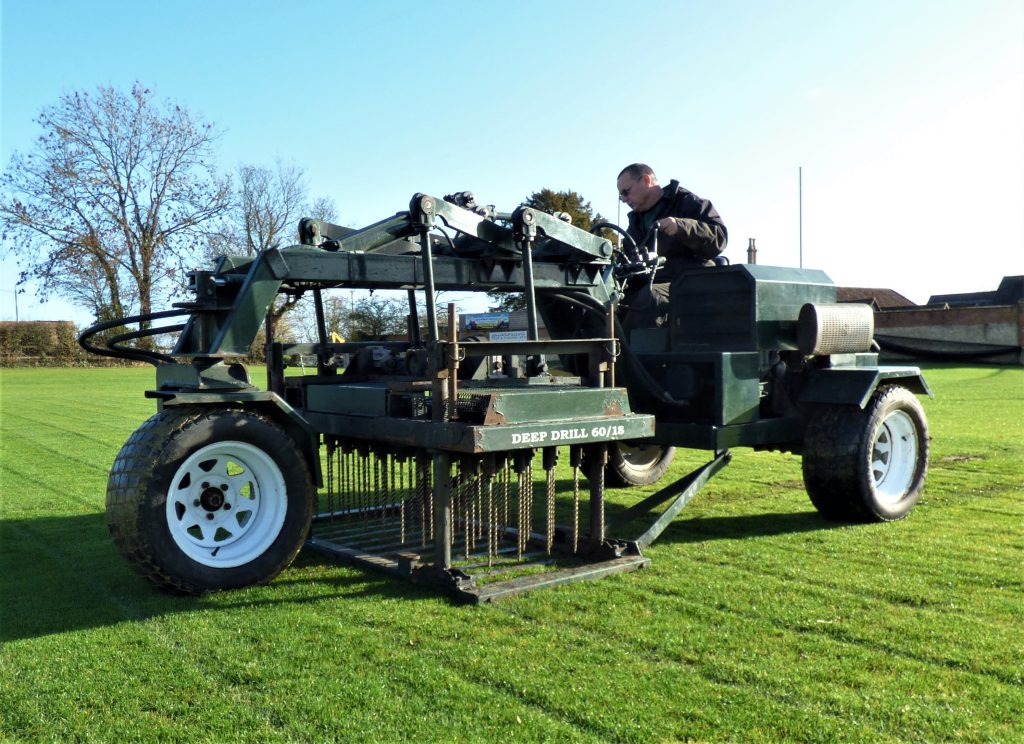
Waterlogging may seem a million miles away during the last droughty summer, but when it rains, poorly aerated greens suffer puddling on the surface, making greens unplayable.
The aerator works by removing soil with the drills, allowing lateral movement within the rootzone and releasing compaction pressure. Deep penetration breaks through sub-surface hard pans, thatch, black layer and rootzone, folding back the grass without the further compaction-inducing impact of other systems and the turf can be put back afterwards to allow rapid healing. Holes can be backfilled with kiln-dried sports sand, often mixed with a soil amendment such as Ecosol’s own zeolitic Sportslite to maintain the improvement. Sportslite will improve the rootzone’s cation exchange capacity and nutrient uptake, resulting in better germination and grass growth.

Deep holes encourage deep rooting and the sizes of drill channel vary from 10mm to 32mm. The Drill n Fill puts the soil amendment directly into the rootzone. This holds open the drainage channel, giving extended duct life and facilitating nutrient exchange between the amendment and the grass roots.
Ecosol Turfcare also operates the Deep Drill 60/18 aerator which can penetrate to a depth of 450mm but does not backfill. It is ideal for deep aeration and gas exchange in very compacted golf greens.
Linear aeration can be helpful to penetrate thatch and Ecosol Turfcare can offer treatment with the Graden, as well as a variety of other drainage solutions for any type of sports turf problem.
Wiedenmann
Last year, Wiedenmann’s Terra Spike GXi8 HD was on Twitter in full working mode, a coffee cup balanced as it travelled across a green. The coffee didn’t spill and greenkeepers filmed their versions of the #CoffeeCupChallenge. Impressed, Rick Sinker, course manager at Lymm Golf Club, had dealer, Turner Groundscare, give a demo.
“I liked that depths of seven, eight and nine inches still left the surface smooth. Then you realised its speed; it moved so quickly. Finally, when you examined closely, it was all about neatness,” said Rick. “It went so well that we dispensed with our pedestrian aerator because it couldn’t maintain the same clean finish.”
A year later, the Cheshire club has a thorough aeration programme. Together with an existing Wiedenmann XP6, Rick and his team have made steady progress.
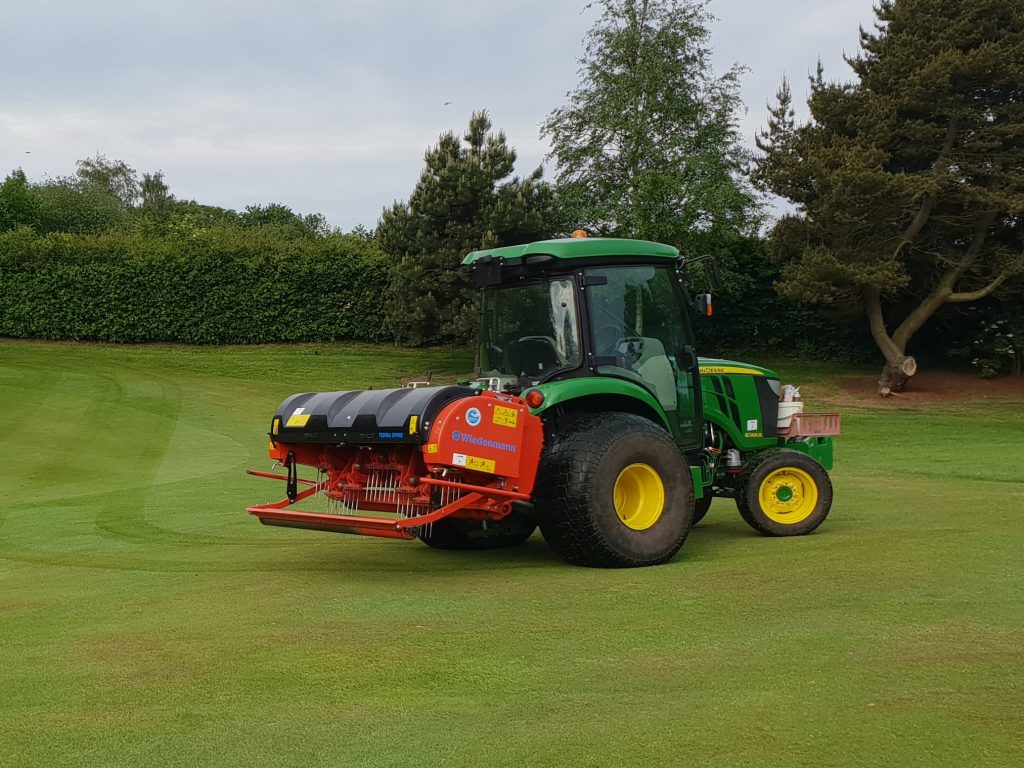
“After you’ve aerated with a GXi8 every other machine seems outdated. Sometimes you don’t even need to cut the grass afterwards. Nothing I’ve used elsewhere is as discrete nor comes close to such minimal disruption.
“Primarily, GXi8’s main job was on greens, monthly. However, it was so fast we tried it with 20mm tines on approaches and tees. The GXi8 goes to 250mm, so not quite the 400mm depth of the larger XP6, but together they are formidable. It was so good we let it do more across the course.
“Surfaces are getting better and better. We do greens, monthly, with the GXi8 on 8mm tines altering depth. It does approaches with 12mm tines, two or three times a year and tees twice. At maintenance in April and September, the XP6 goes the full 400mm on tees and approaches. The XP6 (2012) still leaves a lovely finish. We repeat on top with the GXi8, using 8mm tines, maximising smoothness.”
Toro
Aeration is widely recognised as the most important task implemented on fine turf.
Tractor-mounted or pedestrian, mechanical or air combined, when it comes to choosing the right machinery for the job there are of course numerous options. The universal requirement though is minimal surface disruption and a machine that can be relied upon to get turf back into play as soon as possible.
The way aeration machinery has progressed over the years now means the process is so much more efficient and time-effective. From taking three people up to two and a half hours to aerate one green, these days 18 greens can be done in less than a day thanks to innovative product development and new technology as seen in Toro’s ProCore 648 pedestrian aerator.
Whetherhollow- or solid-tining, the ProCore 648, as with all Toro aerators, leaves a clean, even finish that allows operation on fine turf with the absolute minimum of disturbance and gets surfaces back into play quickly.
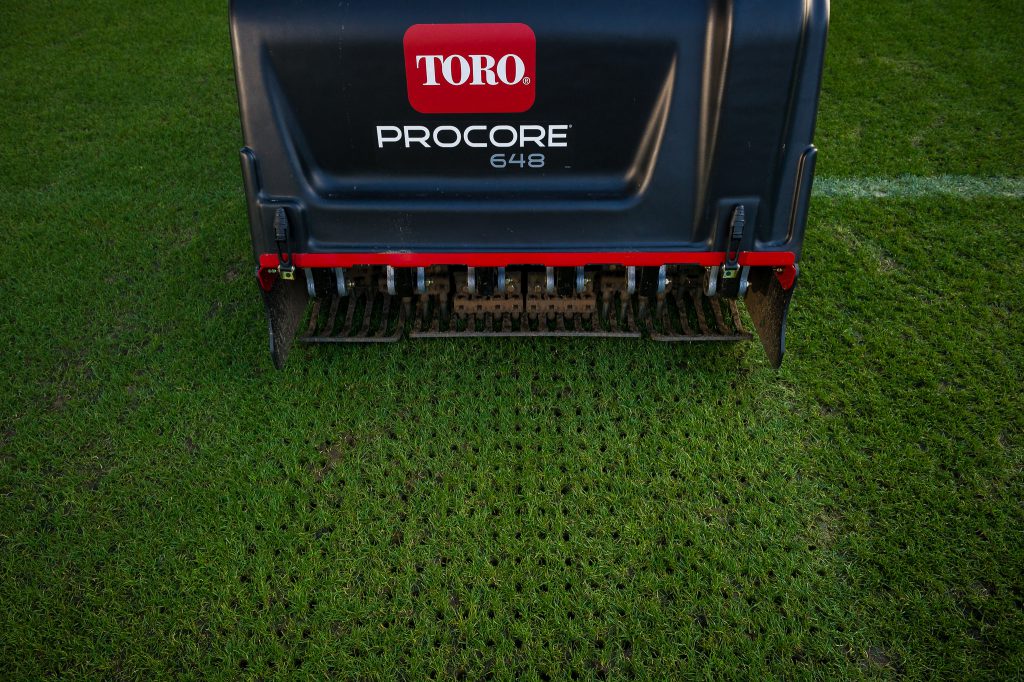
Fitted with a head drive system that uses precision balancing weights, similar to those found on a six-cylinder engine, on each coring head, this configuration eliminates hopping, rocking and uncomfortable vibration.
From the innovative wheels within the coring path, to the large 122cm aeration swath, the Toro ProCore 648 is one of the most productive and efficient pedestrian aerators on the market.
Other extras that make for easier aeration, also seen in the ProCore 648, are a ground following system so the machine matches ground undulation for consistent and even coring, and core deflectors which are fitted in front of the tyres to eliminate running over the pulled cores from the previous pass to make the clean up process far easier.
The tractor you use for a mounted aerator can make a big difference to productivity, too. Some allow an aerator to just overlap the tread width of the tyres meaning you don’t need to run back over the same area. Illustrating this perfectly is the combination of a TYM T433 and Toro SR72 aerator.
TYM is, says Reesink, the UK distributor of TYM and Toro, the perfect choice when working alongside Toro equipment and the design of the SR72 makes life easy by allowing tine depth to be adjusted without changing the angle of entry. By using the hydraulic top link from the tractor while the machine is in use, the operator can apply the ideal tine position for every soil type and condition, without leaving their seat.
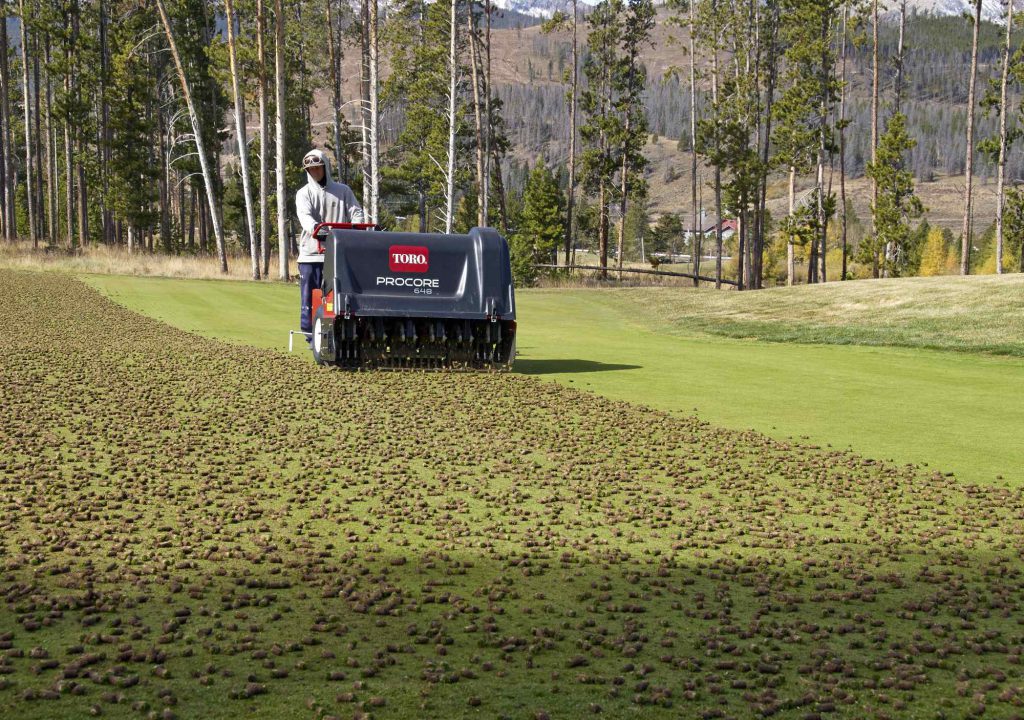
If you have a large area to cut, look no further than the ProCore 1298. Alsotractor-mounted the 1298 is, along with the Toro Pro Core 864, one of the smoothest large-area aerators on the market. And being one of the widest too means you can cover more ground in less time. In fact, the ProCore 1298 can aerate up to 2.3 acres per hour, with dual coring heads that articulate to follow undulations. Plus, with its tines and accessories also fitting the 648, there’s the added benefit of cost savings for those turf professionals who use both.
Successful aeration is as much down to the quality and condition of the tines in use as it is the machine. In order to maintain your turf, it’s vital to ensure you have the very best equipment and parts to hand. Clean-cut holes are important for a speedy recovery and the best way to ensure this is with sharp, smooth, good quality Toro tines. They produce precise, consistent holes for faster turf recovery, a smooth finish and speedier return to play by maximising core-pulling and producing a superior quality hole. There are literally hundreds to choose from, and to suit every turf application, soil situation and season.
And what you choose will be dependent on what is the right size and shape of tine for the ground conditions. For example slit, cross and chisel tines are the best choice for summer aeration on dry soil. By creating small incisions in the surface these tines increase gas exchange, improve nutrient penetration into the soil and aid the removal of surface and subsurface water. Or many choose 8mm hollow tines during the hot months to remove thatch build-up and again increase nutrient and water penetration. However, these small holes can cause issues with filling, in which case 12-15mm tines create holes that are far easier to fill. But tining at this size is more disruptive to the soil – there will always be pros and cons!

























